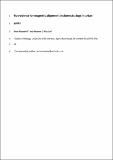Files in this item
No evidence for magnetic alignment in domestic dogs in urban parks
Item metadata
| dc.contributor.author | Rouviere, Anna | |
| dc.contributor.author | Ruxton, Graeme D. | |
| dc.date.accessioned | 2022-12-07T00:41:17Z | |
| dc.date.available | 2022-12-07T00:41:17Z | |
| dc.date.issued | 2021-12-07 | |
| dc.identifier | 277016295 | |
| dc.identifier | 03cc1852-0697-4e20-b751-0d1ca44256dd | |
| dc.identifier | 85123702469 | |
| dc.identifier | 000821046900010 | |
| dc.identifier.citation | Rouviere , A & Ruxton , G D 2021 , ' No evidence for magnetic alignment in domestic dogs in urban parks ' , Journal of Veterinary Behavior: Clinical Applications and Research , vol. In Press . https://doi.org/10.1016/j.jveb.2021.11.005 | en |
| dc.identifier.issn | 1558-7878 | |
| dc.identifier.other | RIS: urn:6DEDFCC213FA47F540FAE141DF530BA6 | |
| dc.identifier.other | ORCID: /0000-0001-8943-6609/work/104618930 | |
| dc.identifier.uri | https://hdl.handle.net/10023/26552 | |
| dc.description.abstract | Spontaneous Magnetic Alignment (SMA), or the phenomenon by which animals orientate their bodies non-randomly with respect to a magnetic field, has been demonstrated in many taxa. While a 2013 study could only detect SMA in domestic dogs under calm magnetic field conditions, a more recent study has reported an extremely strong effect of magnetic alignment in individuals observed in urban dog parks. Here, we replicate their methods by measuring the magnetic orientation of dogs during excretion (urination or defecation) in five dog parks in the city of Lyon, France. We report no detectable SMA, though the alignment of the dogs was non-random relative to the orientation of the parks in which they were located. We suggest that urban dog parks present many distractions to dogs, all of which have the potential to influence the orientation of dogs during excretion. We discuss the potential of unconscious observer bias by the volunteer members of the public who collected the data. Though we recognise the benefits of citizen science, we recommend that in such cases caution be exercised and safeguards put into place to minimise observer bias. | |
| dc.format.extent | 233080 | |
| dc.language.iso | eng | |
| dc.relation.ispartof | Journal of Veterinary Behavior: Clinical Applications and Research | en |
| dc.subject | Spontaneous magnetic alignment | en |
| dc.subject | Magnetic orientation | en |
| dc.subject | Domestic dog | en |
| dc.subject | Magnetoreception | en |
| dc.subject | Citizen science | en |
| dc.subject | Replication | en |
| dc.subject | QL Zoology | en |
| dc.subject | NDAS | en |
| dc.subject | AC | en |
| dc.subject.lcc | QL | en |
| dc.title | No evidence for magnetic alignment in domestic dogs in urban parks | en |
| dc.type | Journal article | en |
| dc.contributor.institution | University of St Andrews. School of Biology | en |
| dc.contributor.institution | University of St Andrews. Centre for Biological Diversity | en |
| dc.identifier.doi | https://doi.org/10.1016/j.jveb.2021.11.005 | |
| dc.description.status | Peer reviewed | en |
| dc.date.embargoedUntil | 2022-12-07 |
This item appears in the following Collection(s)
Items in the St Andrews Research Repository are protected by copyright, with all rights reserved, unless otherwise indicated.

